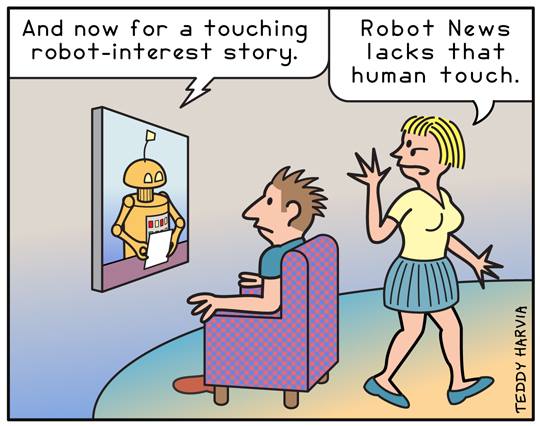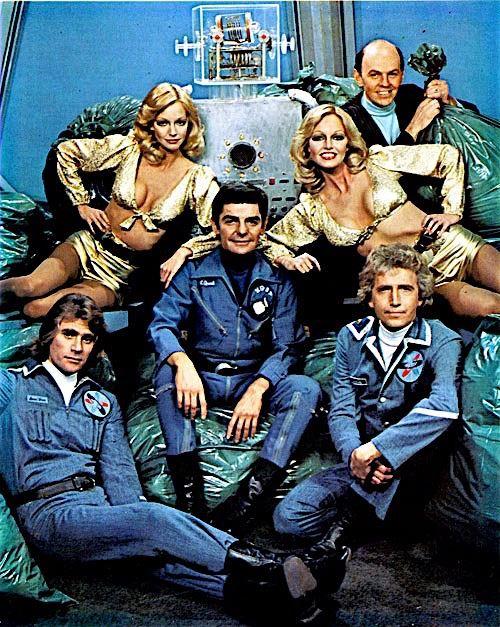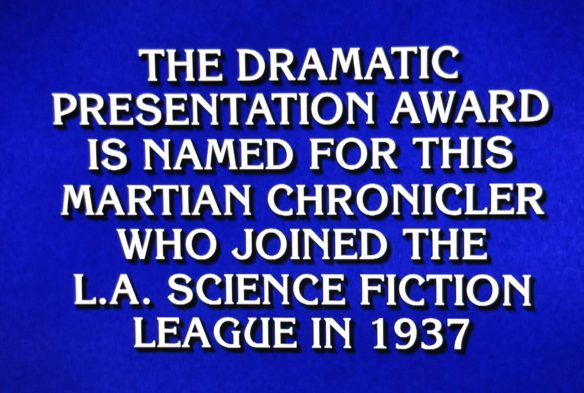(1) JEOPARDY! Tonight’s installment of Jeopardy! featured an entire category about the Nebula Awards. The first clue even mentioned the L.A. Science Fiction League of 1937. Andrew Porter provides screencaps. (Click for larger image.)
(2) TURN BACK THE CLOCK. Internet Archive Blog proudly points to a“Major SciFi Discovery Hiding in Plain Sight at the Internet Archive”.
Fans of science fiction learned last week that the word “robot” was first used in 1920—a full three years earlier than originally thought.The “massively important yet obvious” change in date was confirmed with a search of the Internet Archive, which has a digitized first edition of the Czech play, R.U.R. Rossum’s Universal Robots, published in 1920. There on the title page, hiding in plain sight in an English-language subtitle to the work, is the earliest known use of the word “robot.”
This important piece of information is one of many little-known facts captured in the Historical Dictionary of Science Fiction. The project was completed this year by historian Jesse Sheidlower,…

(3) PROGRESS REPORT. Alastair Reynolds, in “We’ve been landing on Mars for a long time”, compares the length of time probes have been going to Mars with a benchmark in the history of eartbound aviation.
(4) THE WRIGHT STUFF. There was a lot more mileage left in the old bird after all: “Part of Wright brothers’ 1st airplane on NASA’s Mars chopper” reports AP News.
A piece of the Wright brothers’ first airplane is on Mars.
NASA’s experimental Martian helicopter holds a small swatch of fabric from the 1903 Wright Flyer, the space agency revealed Tuesday. The helicopter, named Ingenuity, hitched a ride to the red planet with the Perseverance rover, arriving last month.
Ingenuity will attempt the first powered, controlled flight on another planet no sooner than April 8. It will mark a “Wright brothers’ moment,” noted Bobby Braun, director for planetary science at NASA’s Jet Propulsion Laboratory.
The Carillon Historical Park in Dayton, Ohio, the Wrights’ hometown, donated the postage-size piece of muslin from the plane’s bottom left wing, at NASA’s request….
(5) BLUE PLAQUE SPECIAL. “Campaign to buy JRR Tolkien’s Oxford home fails” reports The Guardian.
An appeal to the public to raise £4.5m to buy JRR Tolkien’s former home in Oxford has failed.
Project Northmoor launched a crowdfunding campaign in December to raise money to acquire Tolkien’s former house at 20 Northmoor Road in Oxford, before it was put on to the market. Backed by names including Martin Freeman and Ian McKellen, who played Bilbo Baggins and Gandalf in adaptations of Tolkien’s novels The Hobbit and The Lord of the Rings, the campaign said it wanted to turn the Grade II-listed property into “the first literary centre in the world dedicated to Tolkien”, and that it needed £4.5m to do so.
The Tolkien Society distanced itself from the project, after being approached for support by organisers, saying that the house “would not be a museum and would not be open to the public”, and that given the property is a listed building and already has a blue plaque celebrating the author, it is “well protected under the law and not in need of rescue”. The Tolkien Society was also concerned that plans it had seen for the property included “spiritual retreats”, that the charity’s “business model includes running a bed and breakfast, with a full-time resident warden”, and that its “primary intention appears to be to run creative workshops, rather than educational programmes about Tolkien”. It was also critical of the fact that “no prominent members of the Tolkien community – be they writers, academics, artists etc – are directors of the company”…
(6) “BLERDS” EXPLORE INTERSECTION OF BLACKNESS AND NERDINESS. Adam Bradley of the New York Times offers an insightful article titled “The Black Nerds Redefining the Culture”. In it, he traces how race and nerd subcultures overlap and affect each other.
“Blerds still love the same types of content [as other nerds],” Terril “Rell” Fields, the 33-year-old founder of the Raleigh, N.C.-based blerd.com says. “A Blerd just sees nerd culture through their Black cultural lens.” They may notice things that other nerds don’t: a Black or brown supporting character in a comic book that might otherwise be forgotten; a political allegory of race and democracy played out in a sci-fi television series.
(7) THEY CAME IN FROM THE COLD – TO WRITE. In “The Best Spy Novels Written by Spies, According to a Spy” on CrimeReads, sf writer Alma Katsu, a former spy, recommends her favorite spy novels by people who served in intelligence.
…As a retired intelligence professional and a published novelist, and now the author of a spy novel, I’m here to set the record straight: Even when you’ve been in the espionage business, it’s hard to write a good spy novel.
The heart of a good spy novel is not the caper but the personal or moral issue facing the protagonist. In a nutshell, that is the spy business, particularly on the clandestine side. You’re constantly asking yourself, am I doing the right thing? Do the ends justify the means? If I do this questionable thing, what does it mean about me as a person? The best spies—like the best people in general—question themselves. Test their motives. And try to hold themselves accountable. Because—like Spiderman—spies have great power, and with great power comes great responsibility….
Joe Weisberg, An Ordinary Spy
That’s right, the mind behind the brilliant TV series The Americans put a few years in with one of the three-letter agencies. Before his transition to television, he wrote this absolutely true-to-life novel. There was a tussle with CIA’s pre-publication review board that resulted in redactions, which the publisher cheekily decided to leave in. Without fail, when asked what it’s like to work at the Agency, this is the book I recommend. An Ordinary Spy perfectly captures what happens in the beginning, when your James Bond dreams crash into reality.
(8) THERE ARE OLD EQUATIONS, AND BOLD EQUATIONS, BUT THERE ARE NO OLD, BOLD COLD EQUATIONS. Netflix dropped a trailer for Stowaway, about a stowaway aboard a Mars mission,
(9) MEDIA BIRTHDAY.
- March 24, 1978 — Quark was slotted in on NBC as a mid-season replacement series. Yes, the pilot aired on May 7, 1977, so technically that its birthday but let’s skip past that technically please. Quark was created by Buck Henry, co-creator of Get Smart. It starred Richard Benjamin, Tim Thomerson, Richard Kelton, Tricia Barnstable and Cyb Barnstable. It specialised in satirizing popular SF series and films and the Wiki article says three episodes were based upon actual Trek episodes. It lasted but eight episodes, beating Space Rangers by two episodes in longevity. You can see the first episode here.

(10) TODAY’S BIRTHDAYS.
[Compiled by Cat Eldridge and John Hertz.]
- Born March 24, 1852 – Edward Page Mitchell. Editor-in-chief of the New York Sun; pioneering SF author. “The Crystal Man” predated Wells’ Invisible Man; “The Clock That Went Backward” predated The Time Machine – though Wells must be credited for that superb name, and story; faster-than-light travel (“The Tachypomp”) in 1874; other firsts. See Sam Moskowitz ed., The Crystal Man (1973). More here. (Died 1927) [JH]
- Born March 24, 1874 — Harry Houdini. His literary career intersects the genre world in interesting ways. Though it’s not known which, many of his works were apparently written by his close friend Walter B. Gibson who as you know is the creator of The Shadow. And one famous story of his, “Imprisoned with the Pharaohs”, was actually ghost written by Lovecraft! ISFDB lists another piece of genre fiction for him, “The Spirit Fakers of Hermannstad”. (Died 1926.) (CE)
- Born March 24, 1897 — Theodora Kroeber. Mother of Ursula K. Le Guin. Anthropologist, Ishi in Two Worlds is the work she’s most remembered for. ISFDB lists her as having but one genre work, a children book titled Carrousel with illustrations by Douglas Tait. Ishi is available on the usual suspects. (Died 1979.) (CE)
- Born March 24, 1911 – Gabriel Mayorga. I know of five covers, half a dozen interiors for us, but he may have done more. Tuned a notable artistic vision to the demands of our publishers. Here is the May 40 Super Science (Fred Pohl, editor). This Jun 40 Astonishing was re-used by Justine Larbalestier for The Battle of the Sexes in SF. Here is the May 41 Super Science Novels (also Pohl). Painted, sculpted, and taught in New York City, working in oil, pastel, watercolor, epoxy, plastic and polyester plastic. Here is Strength (1928) carved from a bar of soap for a contest. He illustrated this Theory and Practice of Fencing. More here. (Died 1988) [JH]
- Born March 24, 1930 — Steve McQueen. He got his big break by being the lead, Steve Andrews, in The Blob. Setting aside the two different roles on Alfred Hitchcock Presents he had which are at least genre adjacent, The Blob is his only genre appearance in his brief life. He died of a heart attack. (Died 1980.) (CE)
- Born March 24, 1946 — Andrew I. Porter, 75. Editor, publisher, fan. Major member of NYC regional fandom starting in the early Sixties. Editor of Algol: The Magazine About Science Fiction which became Starship. Algol / Starship started in the Sixties and was a five-time Hugo nominee in the Seventies, and exceedingly superb reading it was. He won a Hugo for Best Fanzine in 1974, in a tie with Richard E. Geis, who was doing SFR. He founded the newzine Science Fiction Chronicle in May 1980 and published it monthly, eventually selling it to DNA Publications in May 2000. He has won myriad awards including the Big Heart Award. He has attended hundreds of science fiction conventions and nearly forty Worldcons since his first in ‘63. He was Fan Guest of Honor at several conventions, including the 1990 Worldcon. And with John Bangsund, he was responsible for Australia hosting its first Worldcon. (CE)
- Born March 24, 1946 — Gary K. Wolfe, 75. Monthly reviewer for Locus for twenty-seven years now and yes, I enjoy his column a lot. His brief marriage to Ellen R. Weil which ended with her tragic early death resulted in them co-writing Harlan Ellison: The Edge of Forever. Old Earth Books has reprinted many of his reviews done between 1992 and 2006 in Soundings: Reviews 1992-1996. He’s also written several critical looks at the genre, Critical Terms for Science Fiction and Fantasy and The Known and the Unknown: The Iconography of Science Fiction. (CE)
- Born March 24, 1949 — Tabitha King, 72. Wife of Stephen, mother of that writing brood. I met her but once on the lot of the original Pet Sematary a very long time ago. ISFDB to my surprise lists only two novels she’s written solely by herself, Small World and Wolves at the Door, and one with Michael McDowell, Candles Burning. None of her books are with her husband which surprised me. (CE)
- Born March 24, 1949 – Bob Walters, age 72. A score of covers, a hundred eighty interiors. Here is Sunspacer. Here is the Dec 84 Asimov’s. Here is the May 85 Analog. Here is A Thunder on Neptune. [JH]
- Born March 24, 1960 – Lene Kaaberbøl, age 60. A score of novels for us; also crime fiction. Nordic Children’s Book Prize. Morgensen Prize. First published at age 15. “I was born in Copenhagen, by mistake, really, since my parents are both Jutlanders…. the distinction may appear trivial to non-Danes, but to insiders it is a crucial one!… The Morning Land was one of the first … Danish fantasy novels for adults.” Silver medal in pétanque at the World Championships. [JH]
- Born March 24, 1975 – Carl Hancock Rux, age 46. Author of novels, essays, poems, plays, songs; actor and director; instrumentalist, singer (five solo albums, a dozen singles). Village Voice Literary Prize, NY Fdn. for the Arts Prize. Alpert, Bessie, Doris Duke, Obie Awards. Asphalt (novel, play) is ours. More here. [JH]
- Born March 24, 1988 – Viktoria Gavrilenko, age 33. Three covers for us. Here is Villains, Inc. Here is Young Sentinels. Freelance concept artist and illustrator (also as “Viccolatte – call me Vik”); other occupations, tea drinking, writing, staring at ducks. [JH]
(11) COMICS SECTION.
- xkcd’s “IMDb Vaccines” illustrates an eccentric thought experiment about a scene in Star Wars: Return of the Jedi.
- Frank and Ernest discuss the legal issues of a monster stomping on a city.
(12) INTERNET RANDALL. Lorelei Marcus replays a famous (at the time) production of Arsenic and Old Lace with Boris Karloff for Galactic Journey readers: “[March 24, 1966] Dark Comedy and Birthday Wishes (a Tony Randall double feature)”.
… For those who are unfamiliar with the show, Arsenic and Old Lace is a dark comedy about two sweet old ladies who murder for fun, and their poor nephew, Mortimer Brewster, who discovers their nasty habit and tries to clean up the whole mess. Further conflict arises when Boris Karloff- I mean Jonathan Brewster, Mortimer’s brother and a notably malicious murderer, returns home to hide out for a while. As you might imagine, insanity ensues….
Though the rest of the cast is marvelous, I’d have to say Tony Randall gives the best performance as Mortimer Brewster, the straightman nephew. You may believe I have a slight bias in favor of Randall at this point, and that’s probably true, but I think it’s also fair to say that his execution of Mortimer ties the whole show together.
(13) BEEN THEN, DONE THAT. The Science Fiction 101 podcast returns in episode 2, “It’s About Time”.
Phil [Nichols] and Colin [Kuskie] consider the persistence of the concept of time travel. And we have a little guess-the-mystery-sound competition, albeit with no prizes to speak of other than (a) some small kudos and (b) a shout-out on our next episode. (Post a comment if you can identify the sound.)
(14) THE LARCH. “This Wooden Sculpture Is Twice as Old as Stonehenge and the Pyramids” says Smithsonian Magazine. Image at the link – it looks like Groot imitating “The Scream.”
Gold prospectors first discovered the so-called Shigir Idol at the bottom of a peat bog in Russia’s Ural mountain range in 1894. The unique object—a nine-foot-tall totem pole composed of ten wooden fragments carved with expressive faces, eyes and limbs and decorated with geometric patterns—represents the oldest known surviving work of wooden ritual art in the world….
Based on extensive analysis, Terberger’s team now estimates that the wood used to make the Shigir statue is about 12,250 years old. Carved from a single larch tree with 159 growth rings, the object itself was likely crafted around 12,100 years ago, at the end of the Last Ice Age, reports Michelle Starr for Science Alert.
(15) BEFORE 42. CBC previews a new book that reveals “Even Hitchhiker’s Guide To The Galaxy author Douglas Adams struggled with writer’s block”.
Writing didn’t always come easily for Douglas Adams.
That may be a surprise to fans of the late British comedy and sci-fi writer, whose prolific resume includes the iconic novels The Hitchhiker’s Guide to the Galaxy and Dirk Gently’s Holistic Detective Agency, as well as classic episodes of Doctor Who and Monty Python.
But it’s no surprise to his sister Jane Thrift, who was there when he was writing some of his most famous works, and often got a sneak peek at his earliest drafts.
“If it was going well, oh, it was exciting. He’d call you in and print it off the printer or show you what he’d written and he’d stand there. And it was a bit tricky sometimes because he was just waiting for the expression or the laugh,” Thrift told As It Happens host Carol Off.
“But the times when it was difficult — those were difficult. Those were hard. It was hard to watch him go through that process. And I think it was probably as he became more successful, he knew the value of each word and it had to be perfect.”
Adams’s insecurity about his own writing is one of revelations about the author’s inner-life that will be explored in the forthcoming book 42: The Wildly Improbable Ideas of Douglas Adams. …
(16) THEY CAN’T SEE YOU COMING. Smithsonian Magazine answers “How Does Your Vision Compare to Other Critters in the Animal Kingdom?”
Ever wondered what the world looks like through a cockatoo’s eyes? How about a giraffe—or even a butterfly?
For a new study published last month in Trends in Ecology & Evolution, a team of researchers set out in search of answers. As lead author Eleanor Caves explains in a press release, humans have higher visual acuity than most members of the animal kingdom, who “see the world with much less detail than we do.” And in recent decades, researchers have been slowly teasing apart how clear (or blurry) each critter’s view of the world is.
… As the measure decreases, an animal’s (or individual’s) vision worsens: At less than 10 cycles per degree, a human is deemed legally blind. The majority of insects, however, are lucky to see even one cycle per degree.
(17) STILL MORE SHAT! Birthday week continues with “William Shatner for the Commodore VIC-20” on YouTube. Shat learns that in 1982 you can play computer games on a computer!
(18) VIDEO OF THE DAY. “The Cloudy Dog Talk About” on Vimeo is a cartoon by Asami Ike for Filers who know dogs are their friends!
[Thanks to JJ, Mike Kennedy, Rich Lynch, Michael Toman, Martin Morse Wooster, Olav Rokne, Cat Eldridge, John King Tarpinian, John Hertz, Jennifer Hawthorne, and Andrew Porter for some of these stories. Title credit goes to File 770 contributing editor of the day Andrew (not Werdna).]
Discover more from File 770
Subscribe to get the latest posts to your email.






FIRST
(3) I clipped every article and cartoon about the 1976 Viking mission when I was a lad.
Thanks for the title credit!
Today I finished Micaiah Johnson’s The Space Between Worlds. It’s a great read. When I was halfway through I thought it was light on worldbuilding, and while that didn’t change, the story is very well crafted (even tying up some loose ends I only felt at a nonverbal level) and brings it all home in an emotionally powerful ending.
(15) I can’t recall now where I came across this quote from Adams: “I love deadlines. They make such a great whooshing sound as they go by.”
I can identify with those Adams feels at least, oh, five different ways.
12) [blinks] I am startled that anyone thought the 1944 film version of ARSENIC AND OLD LACE with Gary Grant was less than enjoyable. My wife’s taste in movies and mine don’t overlap much, but AAOL (1944) is one we’ve watched and re-watched together a number of times; it never gets old for us.
I wasn’t aware of the 1962 Tony Randall version reviewed at Galactic Journey, but see it’s available on YouTube. Will have to watch and judge for myself. (I like Tony Randall, especially if he has good material to work with, so I’ll probably enjoy it.)
I do remember watching the 1969 tv version with Bob Crane, Fred Gwynne, and Lillian Gish. I remember it as lackluster and claustrophobic feeling (too many tight shots and closeups), though after 50+ years I may be remembering it too harshly.
PhilRM says I can’t recall now where I came across this quote from Adams: “I love deadlines. They make such a great whooshing sound as they go by.”
It’s in The Salmon of Doubt: Hitchhiking the Galaxy One Last Time which has an unfinished Dirk Gentlly novel plus a lot of random material by Adams.
14) How to recognize different types of pixels from quite a long scroll away
(2) I’m confused as to what the discovery here is supposed to be. R.U.R. was already known to be the origin of the word. How was the date not already 1920? They’re emphasizing that the subtitle used English – so, by “the word was first used” did they mean to say “the word was first used in English“, or “the English plural form of the word was first used”? Either of the latter seems to me an odd detail to fixate on, since it wasn’t being used for an English-language audience at that time.
I feel like someone must have done this before, or something similar, but here you go anyway:
@Bruce Arthurs:
I will leaving completing that to someone with actual musical talent.
17)
Fascinating
(don’t @ me 😉 )
(15) This seems a very poorly kept secret.
(1) Third question being Black Mirror? The rest are easy.
Meredith moment: George Alec Effinger’s What Entropy Means to Me which was nominated for a Nebula is available from the usual suspects for a buck ninety nine.
(2) @Eli: yeah, that story also left me scratching my head.
(4) This made me realise that Yuri Gagarin’s space flight is closer to the Wright Brothers than it is to us.
Not entirely sure if this is a Meredith Moment or just a regular cut price for the first book of the series, but Jo Walton’s Farthing is 99p on Kindle. It’s not mentioned on deals pages, so might be a regular price
@Stuart Hall:
In a few days, the premiere of The Simpsons (in 1989) will be closer to the last radio broadcast of Fibber McGee and Molly than it is to us!
I love that film. One of my close friends absolutely hated it. He really dislikes stories where a thing is going to go wrong, and everyone watching can see it, and the slow unfolding of disaster is what you’re there for.
NickPheas says Not entirely sure if this is a Meredith Moment or just a regular cut price for the first book of the series, but Jo Walton’s Farthing is 99p on Kindle. It’s not mentioned on deals pages, so might be a regular price
Not in the States where each volume in this exemplary trilogy is still going for $11.99! I’ve already purchased them as audiobooks and as ebooks.
Baffled by the description of Douglas Adams as “prolific”… there are many words you could apply to him, most of them good, but “prolific” surely isn’t one of them. I mean, Robert Silverberg, OK, he’s prolific. R. Lionel Fanthorpe? Definitely prolific. Adams? Not so much.
Steve Wright days Baffled by the description of Douglas Adams as “prolific”… there are many words you could apply to him, most of them good, but “prolific” surely isn’t one of them. I mean, Robert Silverberg, OK, he’s prolific. R. Lionel Fanthorpe? Definitely prolific. Adams? Not so much.
ISFDB lists some seventeen novels by him, myriad short works and he had a number of radio scripts as well. Given that he died at age forty nine, I’d say indeed that he was prolific.
I launched Science Fiction Chronicle in August, 1979, had copies of it at the NASFiC in Louisville. There was a blank space on the front page where I rubber-stamped in the Hugo Awards for that year.
Also published Degler! which became the newszine S.F. Weekly. Last issue appeared a few weeks before the first issue of Locus came out.
Scrollareets, Pixels, and FIle, File Wimmen (https://www.youtube.com/watch?v=72mOCLzG9T4)
RIP Jessica Walter. I’m most familiar with her from Arrested Development and Archer, both of which are genre-adjacent at best, but it looks like she did have some other genre roles over the course of her career.
https://deadline.com/2021/03/jessica-walter-dead-actress-arrested-development-1234721873/
@Andrew (not Werdna)
Who are Fibber McGee and Molly? I’ve never heard of them.
Stuart Hall: Fibber McGee and Molly was a popular radio show — from even before my time. Mostly what I know is that the show had a running gag where Fibber would need something from his overstuffed closet, and when he opened the door there would be a prolonged series of sound effects from all the things falling out.
The wikipedia article on Fibber McGee and Molly is helpful. In the late 1940s, it was as much a cultural touchstone as The Simpsons is today, if not more so.
I think Archer has a foot in genre at all times, in no small part thanks to Krieger’s mad science but also there was the Fantastic Voyage episode. And while the next-to-last season may have been nyy n qernz, it still took place in space.
Fibber McGee and Molly is a good comparison to The Simpsons in terms of longevity. It aired from 1935 to 1959 and was about a married couple and their enormous assortment of wacky neighbors. He was a teller of tall tales with a penchant for hare-brained schemes and she played the straight man.
I’m trying to think of a more modern sitcom to compare it to than I Love Lucy. Maybe The Goldbergs? It’s another family comedy where somebody — usually Bev or Barry — does something insane that makes people upset for 20 minutes but it turns into an affirming life lesson in the final 2.
@Eli
First, a little background. Historical dictionaries, like the SF Dictionary and the Oxford English Dictionary, document the usage of a word or term from examples of it in print. Thus, the first example of a word’s use in print is always relevant, and people of a particular bent (like myself, occasionally) will seek to antedate (find earlier examples of) words as they currently exist in dictionaries.
The current entry in the OED for “robot” is:
As the OED and the SF Dictionary are English dictionaries, the citations that document words need to be in English. (This is why they “fixated” on the “odd detail”.) The OED example above mentions the 1920 Czech play as the origin of the word, but doesn’t cite it as a “first use”, presumably because it was written in Czech, and everyone assumed that the document was Czech in its entirety. The NYTimes quote is clearly in English, and thus is cited. The play was translated into English in 1923 (and the OED does include a quote from the translated play as a 1923 cite).
The thing that is new is that Fred Shapiro, a law librarian at Yale and author of The Yale Book of Quotations (who is one of the premier antedaters out there) actually took a look at the published play (which is available on the Internet Archive), and realized that while the play was published in Czech, the subtitle of the play as published was the English-language phrase “Rossum’s Universal Robots”. The English phrase also exists internal to the play, in a description of a poster (as the robots are being marketed in New York). Thus, the word “robot” existed (in plural form) as an English word in 1920, which was earlier than any lexicographers had realized. The common knowledge that the Czech word “robota” was not translated to the English word “robot” until 1923 was wrong.
In retrospect, this is something of a “Well, Duh!” moment. And yet that’s how it happened. I suppose that even when people spoke of the play and called it “Rossum’s Universal Robots”, they just assumed that this was a translation of the title that showed up later, and was not original to the initial published version. A case of historical blinders.
So — This should have been noticed years ago, and wasn’t. A great example of people who should know better locking in to a generally-accepted account which, when examined, turned out to be wrong. And it wasn’t just the staff of the OED, or the editor of the SF Dictionary. The BRW Hugo winner of a few years back, Brave New Words, has the same mistake, and it was passed by editors at Oxford University Press, and by the crowd-sourced OED SF Project (predecessor to the new SF Dictionary) from which it drew. Everyone who bought the book or voted for it had the same opportunity to note the error and communicate it to Jeff Prucher, or to update the OED SF Project. None of us did, until Fred Shapiro. So that’s why this is a big (for very specific values of “big”) deal.
Edit window closed — a couple of places in the post immediately preceding I said “1923” where I should have said “1922”. That is all.
Sorry Stuart. I’m a fan of old radio drama and comedy, and so have an incorrect idea of what other people know about it. As Mike, rcade and bill have said, Fibber McGee and Molly was a hugely popular radio program from the thirties into the late 1950s – and there were a number of catchphrases from it that (like those from the Simpsons) became well-known in American society (Fibber McGee’s closet, “Tain’t funny, McGee,” “That ain’t the way I heard it”) (and probably have faded by now (though there was a kids program in the 2000s that adopted the closet gag (https://en.wikipedia.org/wiki/Zoboomafoo#Running_gags). I thought it was a nice matching comparison to go along with your comparison of the Wright brothers and Gagarin
Jessica Walter was in “Doctor Strange” – the TV movie from 1978 https://en.wikipedia.org/wiki/Dr.Strange(1978_film) (I saw it)
Cat Eldridge: Actually he was. ISFDB lists some seventeen novels by him, myriad short works and he had a number of radio scripts as well. Given that he died at age forty nine, I’d say that he indeed was prolific.
Cat, the ISFDB listing, at a glance, is misleading. His only novel credits are the 5 Hitchhiker novels (which are also duplicated as 5 radio script novel credits) and 2 short fictions, and the 2-1/2 Dirk Gently novels.
The rest are derivations and omnibuses of the Hitchhiker stories, and novel adaptations by other authors of 3 Doctor Who scripts written by a group of writers which included Adams. The collection The Salmon of Doubt is 200 pages of essays by Adams plus the third partial Dirk Gently novel. There are 3 shorter HHGttG “dictionaries” put together by Adams in collaboration with other people.
So he wasn’t particularly prolific, but given that he died at age 49, he still created a decent body of work.
Most of the epispdes of “Fibber McGhee and Molly” still exist. The sponsor, “The Johnson Wax Company, of Racine Wisconsin” loved how the show intergrated the commercials into the shows. Unlike other shows which would pause the action by saying, “We’ll be back after this message from our sponsor”. FM&M would work the commercials into the show. Fibber and Molly would be having a conversation and the phone would ring, there would be a knock on the door ect, and when they answered it, the announcer would give the commercial spiel. When done, Fibber or Molly would hang up or close the door. The other would say, “Who was that?” and the reply would be “It’s that man going on and on about floor wax again”. It so impressed the sponsor, that they requested copies (Airchecks) of every episode be made and sent to HQ.
J&J says So he wasn’t particularly prolific, but given that he died at age 49, he still created a decent body of work.
I stand corrected. Don’t forget his travel book Last Chance to See.
Douglas Adams also co-wrote one (well, at LEAST one) episode of Doctor Snuggles, specifically The Fidgety River.
Rumour has it that it’s actually re-using the plot of a never-filmed Doctor Who script that he wrote.
For a bit more pedantry, I checked the Czech text and the word ‘robot’ is used in there, in that form — the removal of the -a isn’t a novelty for the English translation.
(There are also several variants on ‘robot’ in the text, I which I guess would be standard Czech variants on a noun-stem.)
Thanks for the explanation re Fibber McGee and Molly. Not being American, it is outside my area of familiarity. The radio comedy I’m familiar with from that era are ITMA, Much Binding In The Marsh, The Glums, Doris and Elsie Waters, etc. I think from the description it sounds most similar to The Glums.
Following up on my comment above re: ARSENIC AND OLD LACE.
I watched about a third of the 1962 tv adaptation with Tony Randall.
Nope, still greatly prefer 1944’s movie version. Cary Grant is still Da Man, the Most Mortimer, the Best Brewster.
This disappeared, never posted.
I started SF CHRONICLE in August 1979, not in 1980. First issue was sold at the Louisville NASFic, with a big blank area on the front page, into which I rubber stamped the Hugo winners. Also, I’ve been to 46 Worldcons. 46, that’s not too many…
You need to stop typoing your login.
@Ingvar: I don’t know about the Doctor Snuggles episode, but Dirk Gently’s Holistic Detective Agency is quite obviously frankensteined from the Doctor Who episodes “City of Death” and “Shada” (that last one uncompleted and unaired for several decades).
More Adams credits not yet mentioned: part credit on design and script for the Infocom games The Hitchhiker’s Guide to the Galaxy and Bureaucracy.
Douglas Adams also created and co-wrote the video game Starship Titanic. (Terry Jones wrote a subsequent novelization of it.) We have fond memories of playing it, and figuring out its various puzzles.